WW1 Photos: The New York Times
Photographs and Other Images Sourced from various issues of The New York Times, 1914-1919. A part of a World War 1 Online Exhibit at the GG Archives.
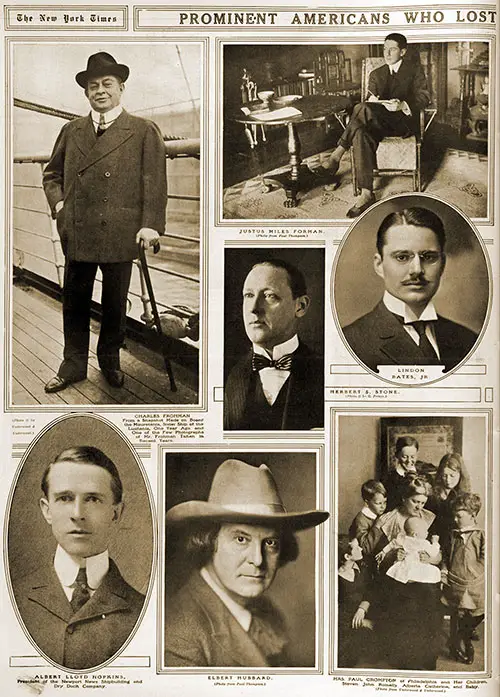
Prominent Americans Who Lost Their Lives on the SS Lusitania: Justus Miles Forman; Charles Fromman; Lindon Bates, Jr.; Herbert S. Stone; Albert Lloyd Hopkins, Elbert Hubbard; Mrs. Paul Crompton of Philadelphia and Her Children, Stephen, John, Romelly, Alberta, Catherine, and Baby. The New York Times, 16 May 1915. GGA Image ID # 194f77de82
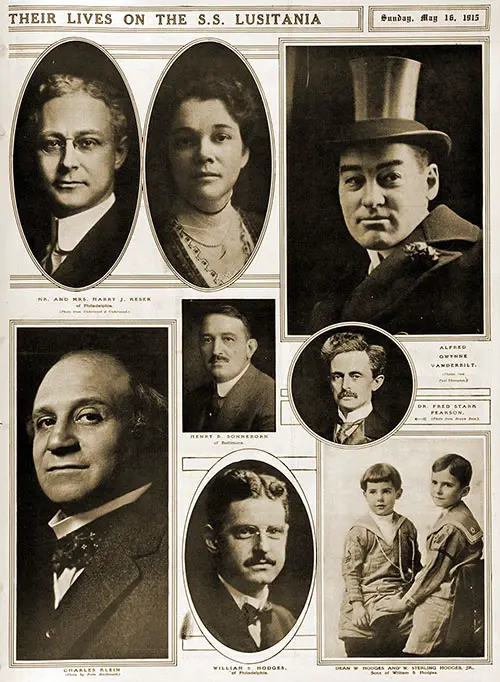
Prominent Americans Who Lost Their Lives on the SS Lusitania: Mr. and Mrs. Harry J. Keser of Philadelphia; Alfred Gwynne Vanderbilt; Dr. Fred Stark Pearson; Henry D. Sonneborn of Baltimore; Charles Klein; William S. Hodges of Philadelphia; Dean W., Hodges and W. Sterling Hodges, Jr., Sons of William S. Hodges. The New York Times, 16 May 1915. GGA Image ID # 194f80f1a3
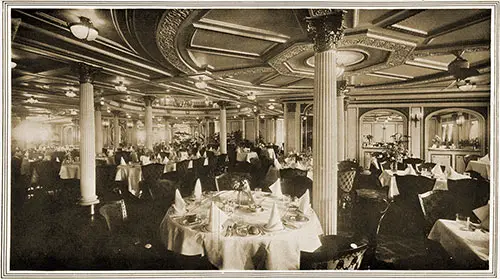
Lower Dining Saloon of the Lusitania, Torpedoed and Sunk on 7 May. The New York Times, 16 May 1915. GGA Image ID # 194fe209b7
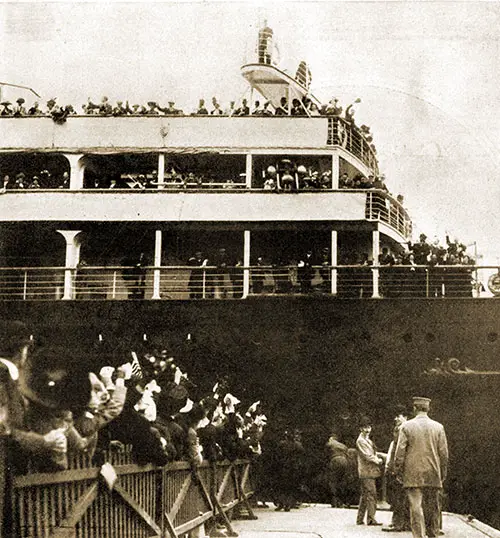
Section of the Crowd on the Pier Waving a Last Farewell to the Lusitania When She Saild from New York for the Last Time on Saturday, 1 May 1915. Captain Turner is Shown on the Bridge. Photo © American Press Association. The New York Times, 16 May 1915. GGA Image ID # 194ff91c22
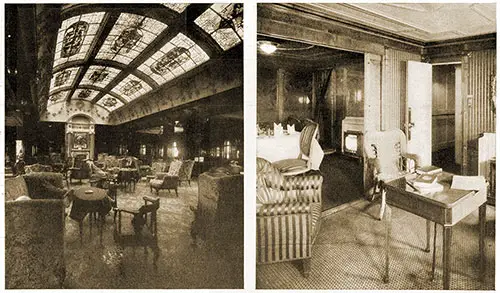
Left: The Lounge on the Lusitania Looking Forward. Right: A "Royal Suite" on the Lusitania, Starboard Side, B. Deck. The New York Times, 16 May 1915. GGA Image ID # 1950bbe1fc
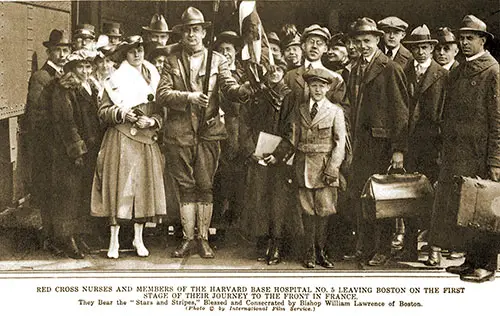
Red Cross Nurses and Members of the Harvard Base Hospital No. 5 Leaving Boston on the First Stage of Their Journey to the Front in France. They Bear the "Stars and Stripes," Blessed and Consecrated by Bishop William Lawrence of Boston. Photo © by International Film Service. New York Times, 13 May 1917. GGA Image ID # 195148a59c
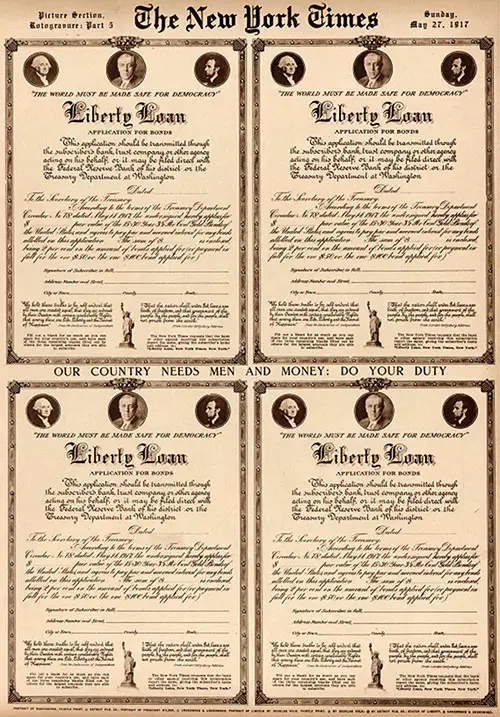
Liberty Loan Application for Bonds -- "The World Must Be Make Safe For Democracy." Our Country Needs Men and Money: Do Your Duty. Fill out a Blank for as Much as You Can Spare for Your Country’s Use, and Have Each of the Three Remaining Blanks Filled out by Others for the Largest Amounts They Are Able to Subscribe. The New York times Requests That the Bank or Other Agency Receiving This Subscription Report the Same, Giving the Subscriber’s Name and Address, to: “Liberty Loan, New York Times, New York.“ New York Times, 27 May 1917. GGA Image ID # 1951b72113
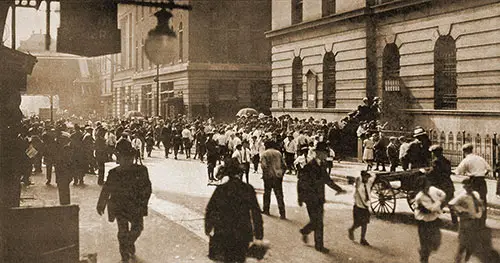
Young Men of the Lower East Side of Manhattan Crowding Into Public School No. 29, Rivington and Forsyth Streets, on Last Tuesday to Register under the Selective Draft Law. Times Photo Service. New York Times, 10 June 1917. GGA Image ID # 1951b93f30
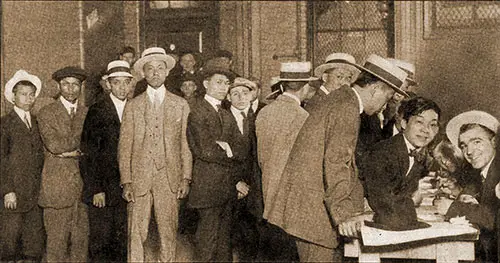
Chinese Residents of New York Registering under the Selective Draft Law at Public School No. 23, Mulberry and Bayard Streets. Photograph © Underwood & Underwood. New York Times, 10 June 1917. GGA Image ID #

A Long Draft Queue Extending Far Up the Block From the Registration Place at 187 West End Avenue. Time Photo Service. New York Times, 10 June 1917. GGA Image ID # 1952c405de
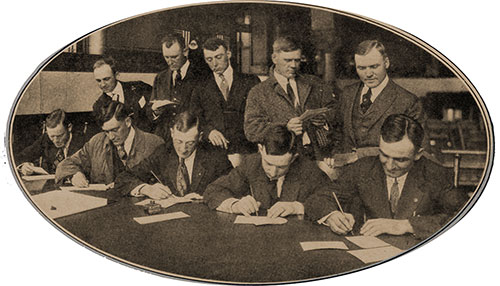
Members of the Cincinnati Reds Baseball Team, National League, Registering Under the Selective Draft Law. Photo © Paul Thompson. New York Times, 10 June 1917. GGA Image ID # 1952f72643
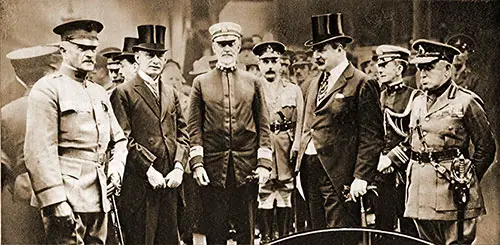
General John J. Pershing, Commanding the American Expeditionary Forces in France, Arrives in London, Where He Is Met by Ambassador Page, Vice Admiral Sims, and Representatives of the British Cabinet and the War Office. in the Group, Left to Right, Are: General Pershing, Walter H. Page, the American Ambassador; Vice Admiral William S. Sims, Commanding American Naval Forces in European Waters; Lord Derby, the British Secretary of State for War, and Field Marshal Viscount French, Commander in Chief of the British Forces in England. New York Times, 1 July 1917. GGA Image ID # 1953600225
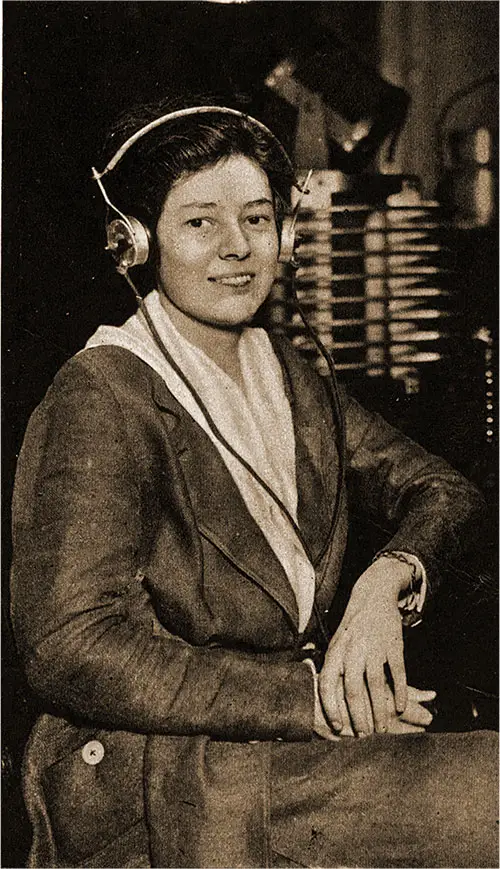
Miss Elizabeth Rickard, First Graduate of the Wireless Class for Women at Hunter College. She Has Also Passed with Highest Rating the U. S. Bureau of Navigation's Examination and Received a First Grade Commercial Wireless License. Times Photo Service. New York Times, 29 July 1917. GGA Image ID # 1951a6359a
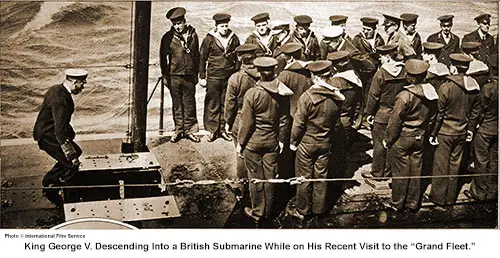
King George V. Descending into a British Submarine While on His Recent Visit to the "Grand Fleet." Photo © International Film Service. New York Times, 29 July 1917. GGA Image ID # 1953b340c2
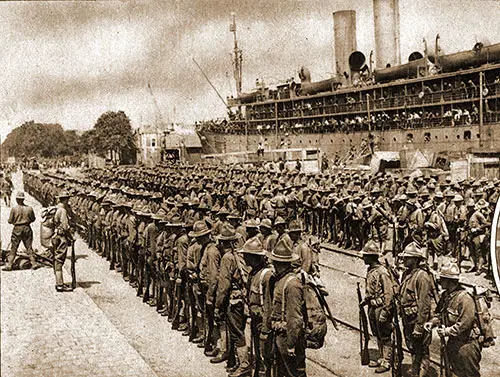
American Infantry, Just Arrived in a French Port, Forming on One of the Docks Preparatory to Marching Away to the Camps Erected for Them beyond the City. Pictorial Press. New York Times, 29 July 1917. GGA Image ID # 19536e1b7f
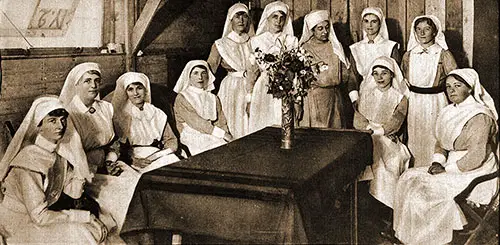
American Red Cross Nurses in the Living Room of Their Portable Hut Behind the Belgian Lines. Pictorial Press. New York Times, 28 October 1917. GGA Image ID # 1953d3403c
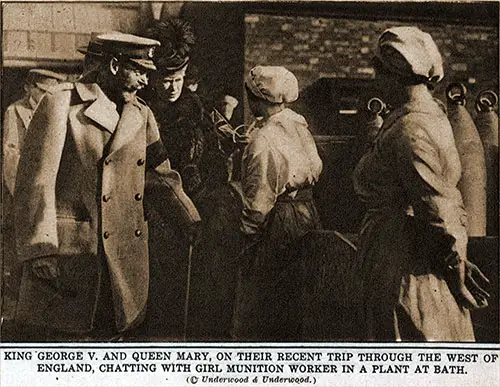
King George V. and Queen Mary, on Their Recent Trip through the West of England, Chatting with Girl Munition Worker in a Plant at Bath. © Underwood & Underwood. New York Times, 9 December 1917. GGA Image ID # 1953daa4e7

The Ill-Fated American Troopship Tuscania Passing Through the Submarine Zone on 5 February 1918, the Day Before She was Torpedoed Off the Irish Coast with the Loss of More than 100 Lives. New York Times, 10 March 1918. GGA Image ID # 1953e04786

King George V. and Queen Mary of Great Britain Making a Surprise Visit to One of the London Council Schools in Winchester Street, Pentonville Road, London. The Children Receiving the Royal Visitors with Entusiasm. Photo © Central News Service. New York Times 17 March 1918. GGA Image ID # 19540df78a
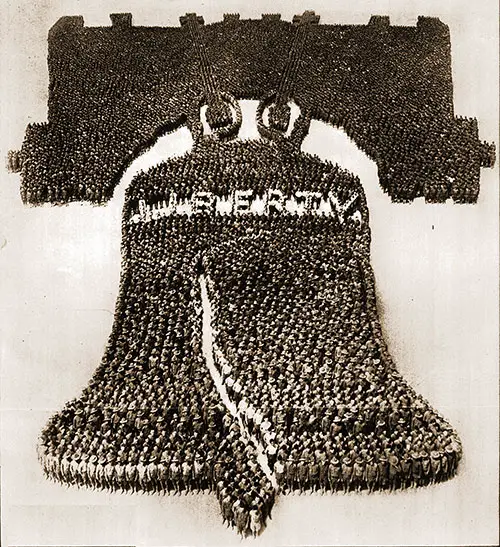
The Living Liberty Bell, Composed of 26,000 Officers and Men in Training at Camp Dix, Wrightstown, - N. J. This Remarkable Photograph Was Taken on the Afternoon of June 20, Last, When the Entire Cantonment Personnel Was Assembled on the Drill Field in Historic Formation to Which Had Been Applied, with Mathematical Precision, the Laws of Perspective. These Are the Bell’s Dimensions in Feet: Length of Beam at Top, 368, Width of Bell at Bottom, 64, Length of Each Bolt, 395, Width of Beam, Top to Bottom, 436, Total Length, Top to Bottom, 580. due to Effecting a Correct Perspective, There Are More than Eleven times as Many Men in the Beam as in the Bell Itself. © Mole & Thomas. New York Times, 21 July 1918. GGA Image ID # 19541497fb
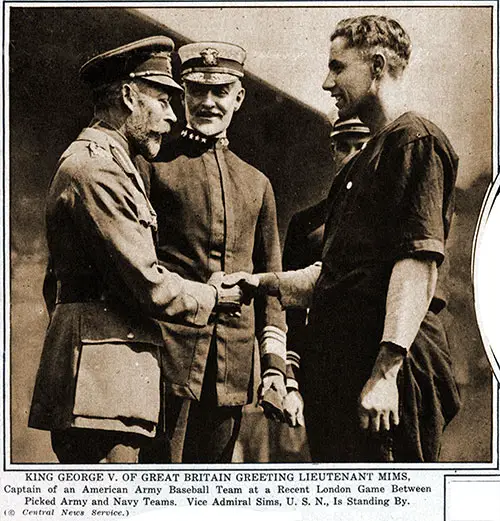
King George V. of Great Britain Greeting Lieutenant Mims, Captain of an American Army Baseball Team at a Recent London Game between Picked Army and Navy Teams. Vice Admiral Sims, U. S. N., Is Standing By. Photo © Central News Service. New York Times, 11 August 1918. GGA Image ID # 195487c0e8
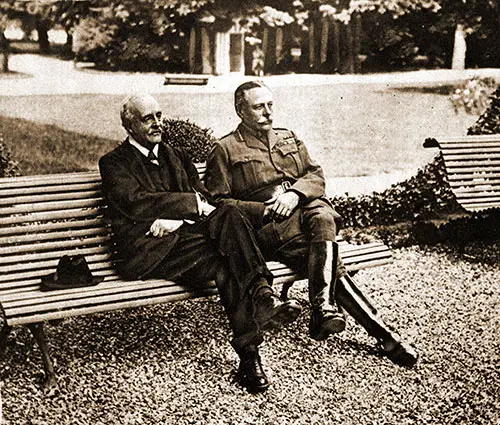
The Right Hon. Arthur James Balfour and Field Marshal Sir Douglas Haig. New York Times, 18 August 1918. GGA Image ID # 1954f35a0a
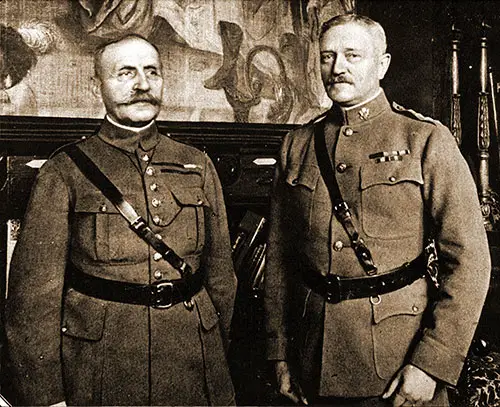
Marshal Ferdinand Foch, Commander-in-Chief of the Allied Forces in Europe, and General John J. Pershing, the American Commander-in-Chief at the American Headquarters in France. Photo © French Pictorial Service. New York Times, 18 August 1918. GGA Image ID # 19552c32a7
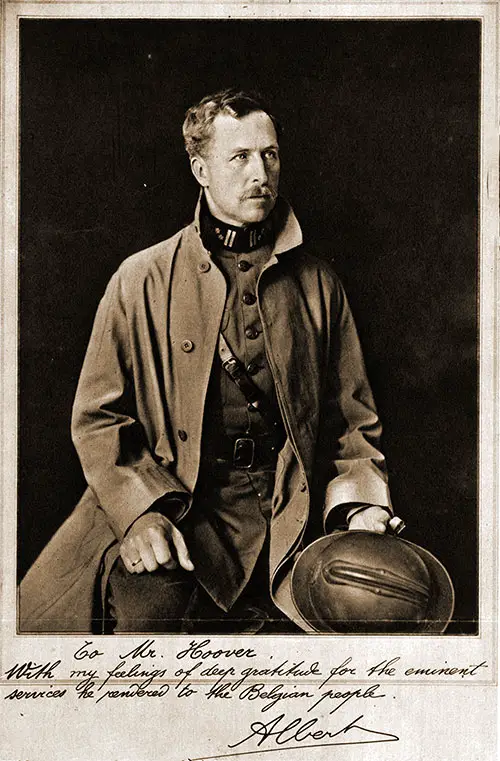
To Mr. Hoover, With my feelings of deep gratitude for the eminent services he rendered to the Belgian People. /s/ Albert, King of Belgium. Herbert Hoover obtained political prominence during World War I through his roles as chairman of the Committee for the Relief of Belgium (CRB) and the U.S. Food Administration. New York Times, 25 August 1918. GGA Image ID # 1955c47473
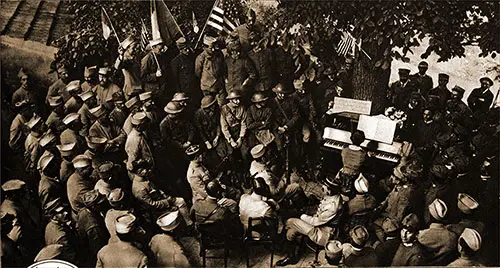
American Soldiers in the Marne Sector Celebrating Bastille Day, July 14, with French Troops as Their Guests, under the auspices of the American Committee for Devastated France, with Miss Lucile Atcherson, Columbus, Ohio, as Pianist. The Celebration Had a Dramatic Ending, the Men, on a Sudden Call to Arms, Going from the Festivities Immediately into the Firing Line. Photos by Harry B. Lach Man an, an American Painter. New York Times, 25 August 1918. GGA Image ID # 1955d65fc9
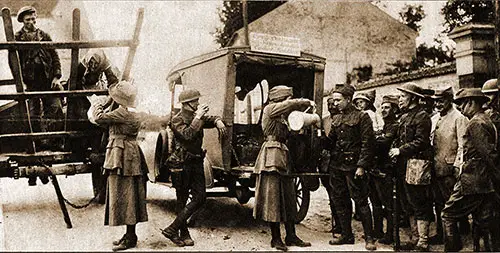
French Refugees and French and American Soldiers Alike Receiving Chocolate from One of the Traveling Canteens of the American Committee, Which, from One Centre Alone, Distributes Every Week Nearly 65,000 Cups of Hot Chocolate among French and American Fighters. New York Times, 25 August 1918. GGA Image ID # 1955e9b1c7
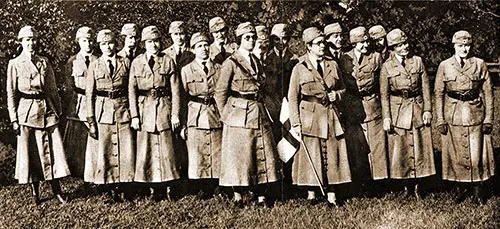
Motor Corps Girls of the Atlantic Division of the American Red Cross Who Drove Sixteen Ambulances from Detroit to New York City for Shipment Abroad. Twelve of the Drivers Are Residents of Buffalo and Four of Westchester County. Photo © Paul Thompson. New York Times, 8 September 1918. GGA Image ID # 1955fefde8
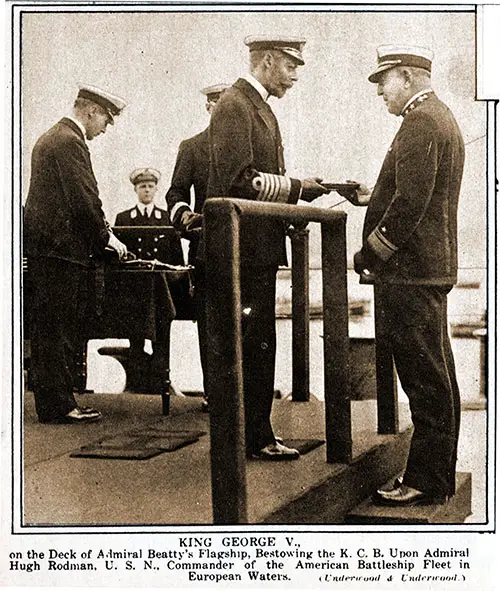
King George V., on the Deck of Admiral Beatty’s Flagship, Bestowing the K. C. B. upon Admiral Hugh Rodman, U. S. N. Commander of the American Battleship Fleet in European Waters. Photo © Underwood & Underwood. New York Times, 15 September 1918. GGA Image ID # 1956283e36
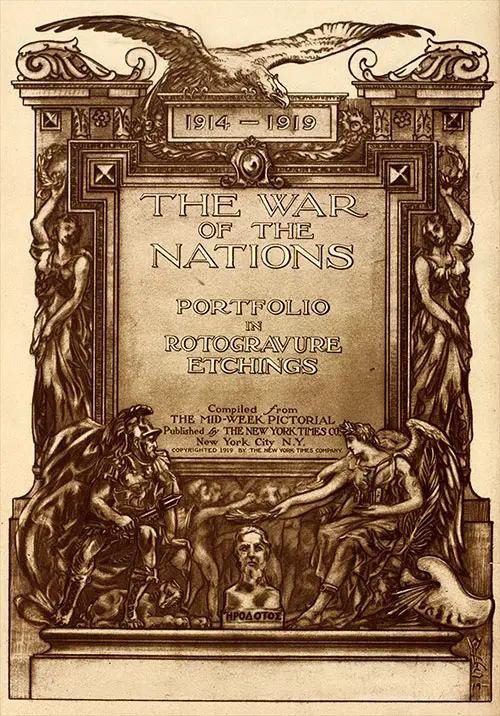
Front Cover, The War of Nations, 1914-1919: Portfolio of Rotogravure Etchings Compiled from The Mid-Week Pictorial, Published by The New York Times, © 1919. GGA Image ID # 195677036a
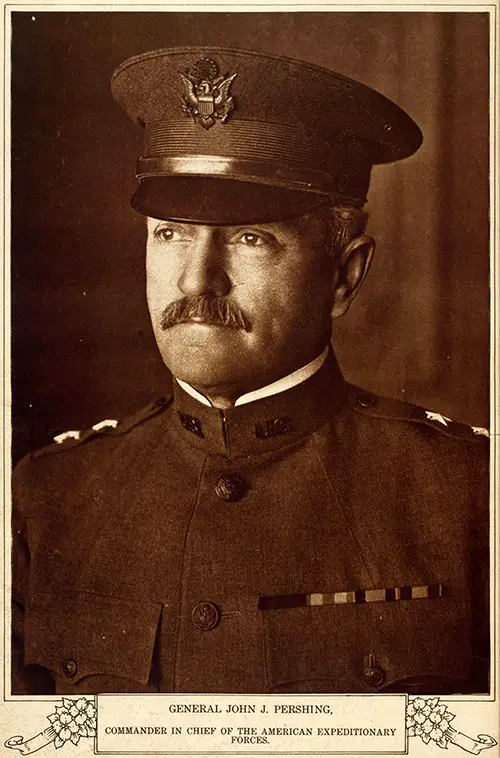
Portrait of General John J. Pershing, Commander-in-Chief of the American Expeditionary Forces. The War of the Nations, New York Times, 1919. GGA Image ID # 1956e897e5
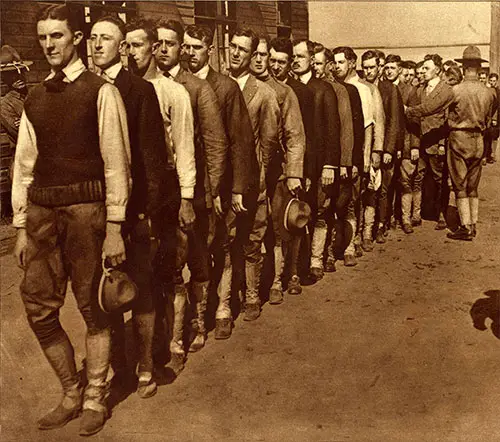
Sorting out New Jersey’s National Army Men according to Their Heights at the Cantonment of Camp Dix. At Wrightstown, New Jersey, in the Fall of 1917. Photograph © Underwood & Underwood. The War of the Nations, New York Times, 1919. GGA Image ID # 1958c1b3e5
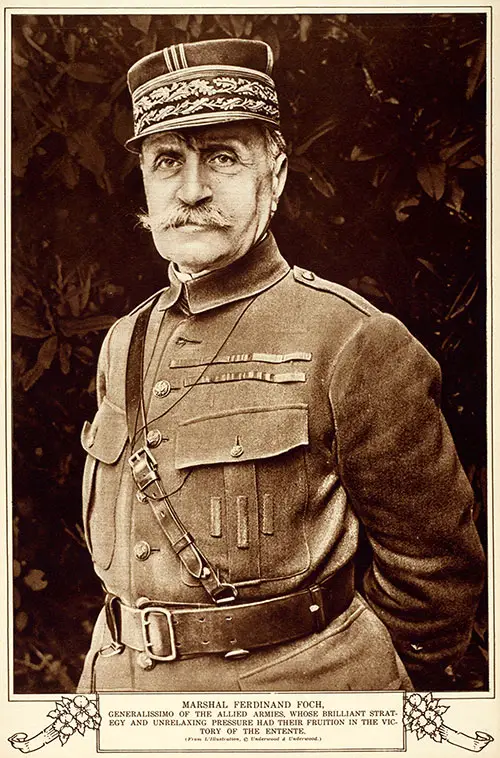
Marshal Ferdinand Foch, Generalissimo of the Allied Armies, Whose Brilliant Strategy and Unrelaxing Pressure Had Their Fruition in the Victory of the Entente. From L'illustration. © Underwood & Underwood. The War of the Nations, New York Times, 1919. GGA Image ID # 1957494037
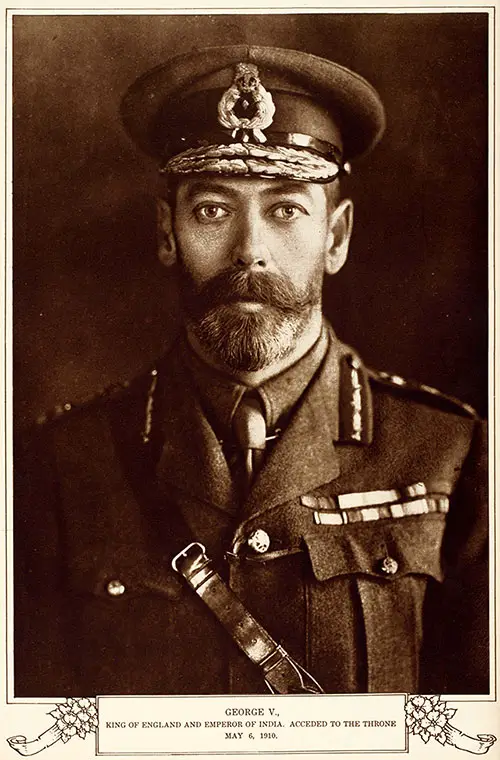
George V., King of England and Emperor of India. Acceded to the Throne May 6, 1910. The War of the Nations, New York Times, 1919. GGA Image ID # 1957556ffd
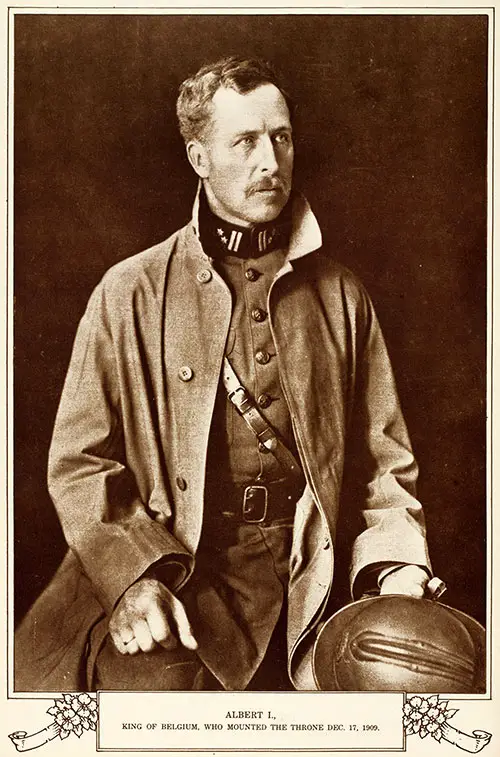
Albert I., King of Belgium, Who Mounted the Throne December 17, 1909. The War of the Nations, New York Times, 1919. GGA Image ID # 1957a7239b
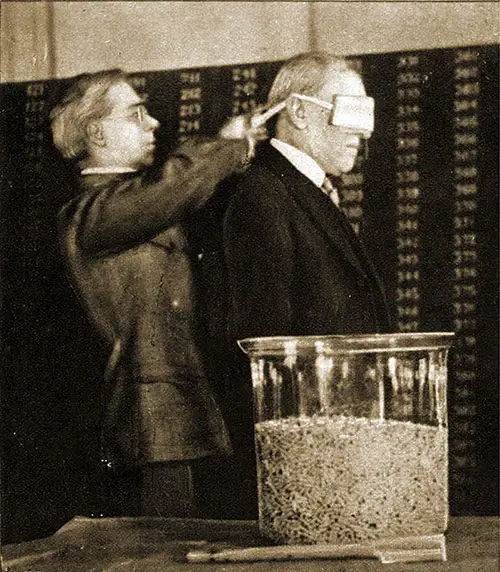
President Wilson Being Blindfolded Preparatory to Drawing the First Capsule from the Bowl in the Ceremonies Attending the Putting into Effect of the Law Extending the Draft Ages to All Males between 18 and 45 Years of Age, Inclusive. The Drawing Took Place on Sept. 30, 1918. 13,000,000 Men Were Made Available by the Draft. Photo © International Film Service. The War of the Nations, New York Times, 1919. GGA Image ID # 1957a8ce26
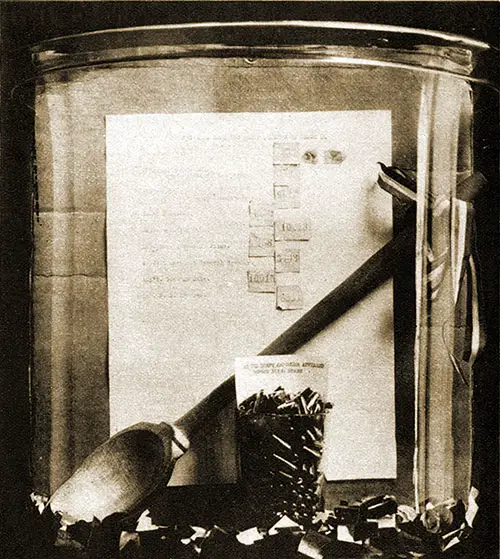
The Draft Bowl and Its Accompanying Paraphernalia, Which Played a Conspicuous Part in the Selection of America’s Army, Will Be Placed near the Liberty Bell in Independence Hall, Philadelphia. The Picture Shows the Bowl, the Wooden Spoon Which Stirred the Capsules. A Number of the Capsules as They Appeared before They Were Drawn. Photo © Harris & Ewing. The War of the Nations, New York Times, 1919. GGA Image ID # 1957e2d974
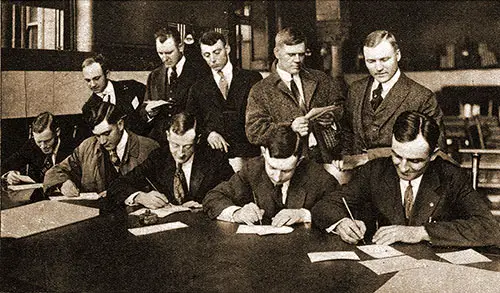
Typical Group of Stalwart American Youth Registering in the Call to the Colors under the Selective Draft Law, September 12, 1918. Photo © Paul Thompson. The War of the Nations, New York Times, 1919. GGA Image ID # 19581c9c3c
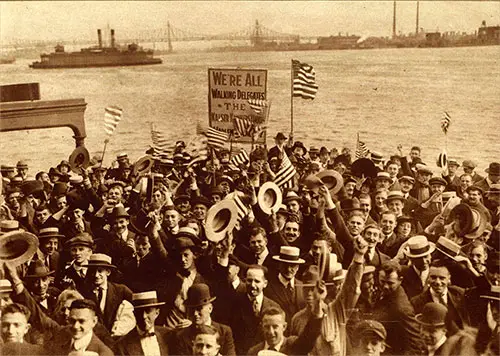
Light-hearted and Enthusiastic Drafted Men Crossing the East River to Take the Train to Camp Upton, Yaphank, Where Their Civilian Clothes Will Be Exchanged for Uniforms. Photograph © Times Photo Service. The War of the Nations, New York Times, 1919. GGA Image ID # 19584266f6
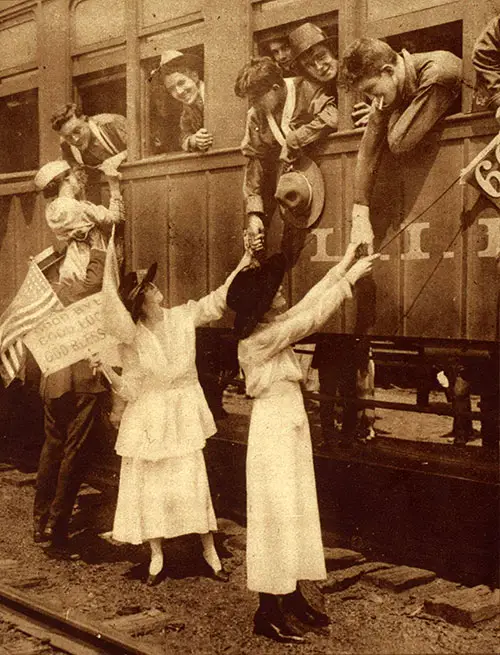
Cheers and Tears for the Old 69th as It Starts on Its First Lap for the French Trenches. Photo © American Press Association. The War of the Nations, New York Times, 1919. GGA Image ID # 195881a9cc
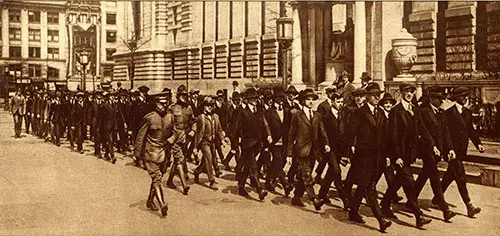
Young Men of the New York State Cadet Officers' Training Corps, All under the Draft Age, Drilling Daily in Bryant Park, Back of the Public Library, New York. Photograph © Underwood & Underwood. The War of the Nations, New York Times, 1919. GGA Image ID # 195884da63
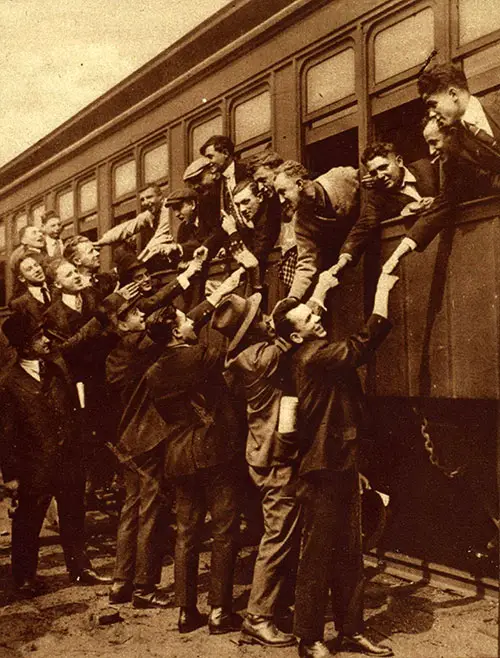
Men of New York City’s Second Quota for the New National Army on Their Way to Camp Upton, Long Island. Photograph © Times Photo Service. The War of the Nations, New York Times, 1919. GGA Image ID # 195885106e
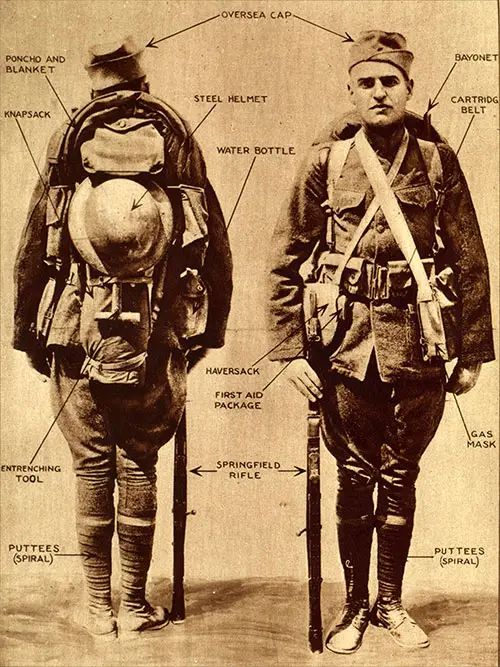
Front and Back View of an American Infantryman, Completely Equipped from Head to Foot and Ready for Action. Photograph © Committee on Public Information. The War of the Nations, New York Times, 1919. GGA Image ID # 1958c28a44
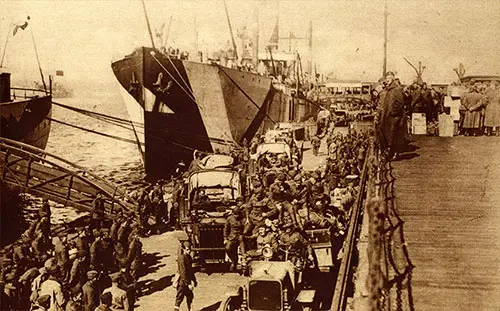
A fleet of Camouflaged American Transports That Have Arrived Safely at the Liverpool Docks and Are Being Unloaded after the Soldiers Have Disembarked. Photograph ® International Film Service. The War of the Nations, New York Times, 1919. GGA Image ID # 1958ef73b8
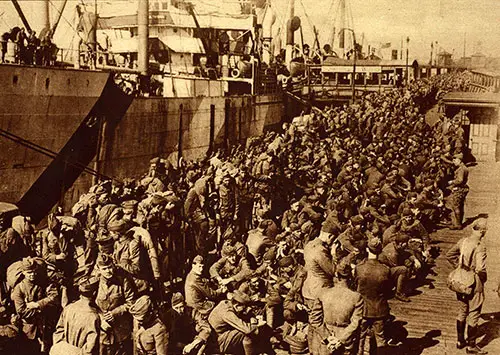
The Last Contingent of America’s Second Million Bound for France Waiting on the Docks at Liverpool to Be Sent on the Second and Last Stage of the Journey. Photograph © International Film Service. The War of the Nations, New York Times, 1919. GGA Image ID # 1958f1c40e
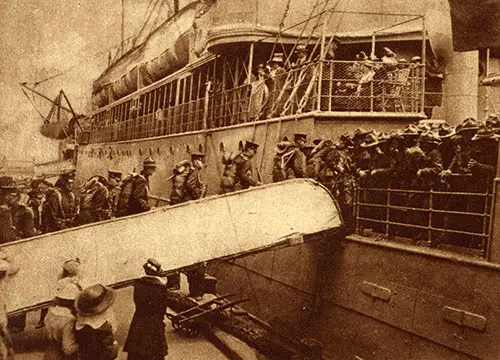
U. S. Marines Going Aboard Passenger Steamer Whose Spare Accommodations Have Been Chartered by the Government. The War of the Nations, New York Times, 1919. GGA Image ID # 19595a91bd
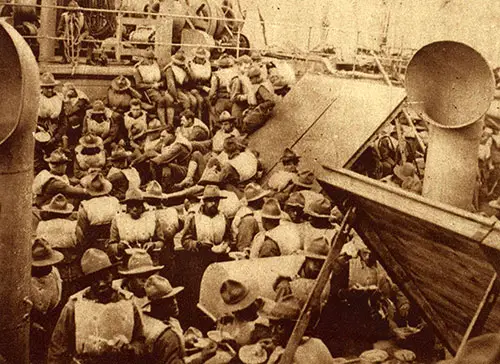
White and African-American Troops Who Have Eagerly Responded to the Call to Mess on Board a Crowded Transport in Mid-Atlantic. The War of the Nations, New York Times, 1919. GGA Image ID # 19597efed4
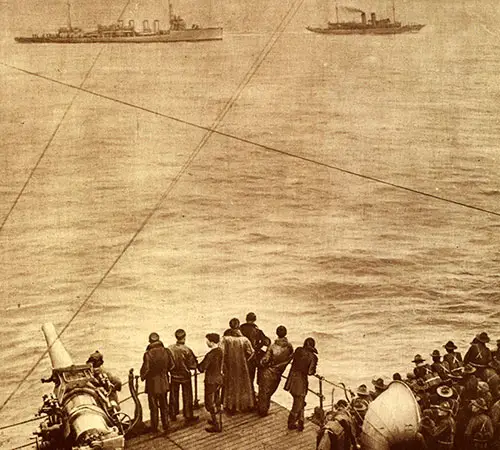
In the Submarine Zone. An Armed Transport with Gun Ready for Instant Use on the Watch for Submarines, While Destroyers and Patrol Boats of the Convoy Keep Vigilant Guard against the Undersea Menace. Photograph © Underwood & Underwood. The War of the Nations, New York Times, 1919. GGA Image ID # 1959a894f9
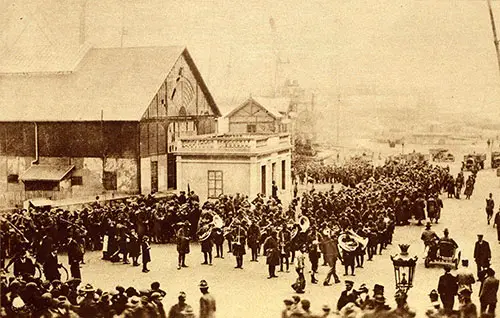
Soldiers of the Rainbow Division Losing Their Sea Legs on French Piers after Safely Passing through the Submarine Zone. The Inhabitants of the Seaport Poured out in Throngs to Greet Them. Photograph © Committee on Public Information. The War of the Nations, New York Times, 1919. GGA Image ID # 1959da67f3
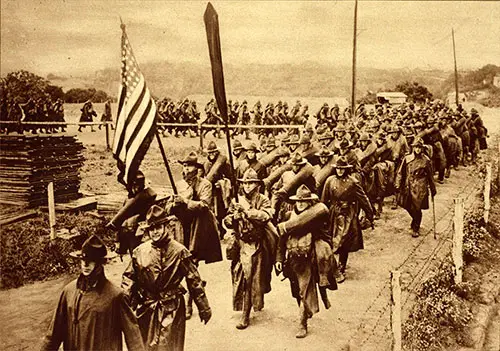
A Detachment of American Troops, after Intensive Training in a Camp Back of the British Lines on the Western Front, Marching Now To Take Part in the Actual Fighting. Photograph © British Official Photo, from Underwood & Underwood. The War of the Nations, New York Times, 1919. GGA Image ID # 195a7b6c17
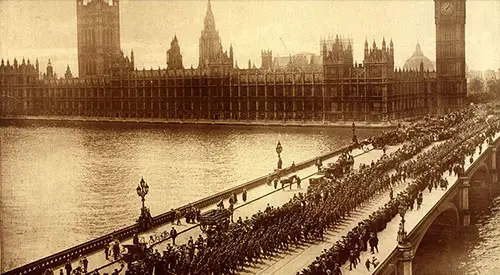
American Soldiers Crossing Westminster Bridge. British Parliament Buildings in the Background. The War of the Nations, New York Times, 1919. GGA Image ID # 195a7f19ba
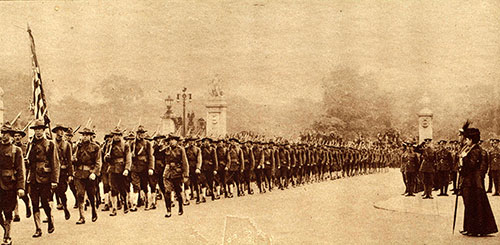
King George V. of England and His Mother, the Dowager Queen Alexandra, Watching the Young Soldiers of America as They Marched past Buckingham Palace, London, England. Photograph © American Press Association. The War of the Nations, New York Times, 1919. GGA Image ID # 195a880be1
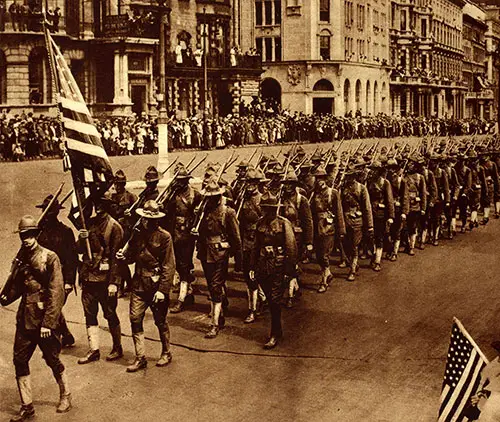
American Troops Swinging down Piccadilly on Their March through London Amid Dense Crowds, Who Greeted Them with Acclamations and Marked Enthusiasm. Photograph © American Press Association. The War of the Nations, New York Times, 1919. GGA Image ID # 195b1621a0
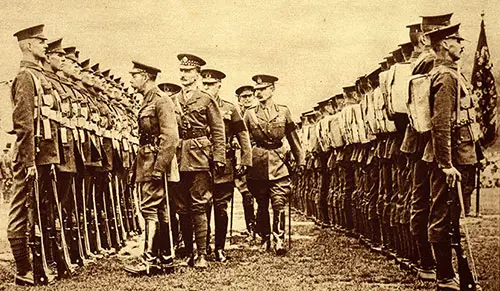
Kitchener's Army, Gathered by the Indefatigable Efforts of the Secretary for War Being Inspected by King George before Being Sent across the Channel to the Firing Line. Photograph © Sport and General Press Agency. The War of the Nations, New York Times, 1919. GGA Image ID # 195b466b5d
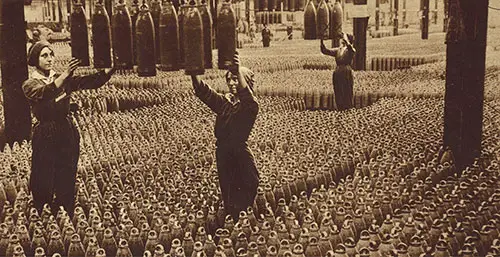
Guiding the Shells down from One of the Overhead Cranes and Assembling Them before Shipment. Supervisors, as well as Workers, Are Women, and the Work Is Satisfactorily Done. Photograph © Underwood & Underwood. The War of the Nations, New York Times, 1919. GGA Image ID # 195ba8837a
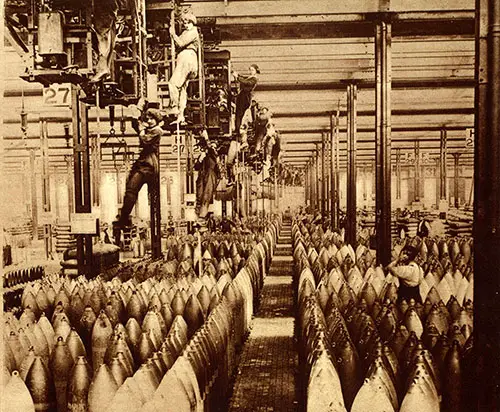
Girls at Work on the Traveling Cranes in One of the Great British Shell Factories. This Is but One of the Myriad Things Done Now by Women That Were Formerly Left to Men. Photograph © Underwood & Underwood. The War of the Nations, New York Times, 1919. GGA Image ID # 195b4f22d1
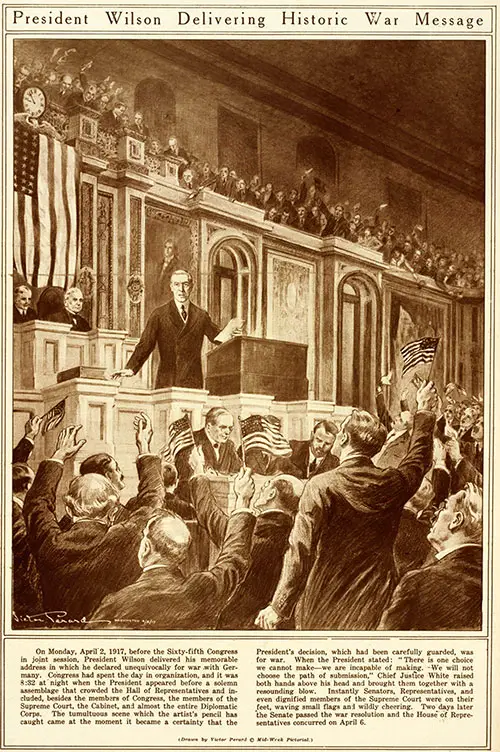
President Wilson Delivering Historic War Message. On Monday, April 2, 1917, before the Sixty-fifth Congress in joint session, President Wilson delivered his memorable address in which he declared unequivocally for war with Germany. Congress had spent the day in the organization. It was 8:32 at night when the President appeared before a solemn assemblage that crowded the Hall of Representatives and included, besides the members of Congress, the Supreme Court members, the Cabinet, and almost the entire Diplomatic Corps. The tumultuous scene which the artist's pencil has caught came when it became a certainty that the President's decision, which had been carefully guarded, was for war. When the President stated: "There is one choice we cannot make—we are incapable of making. We will not choose the path of submission," Chief Justice White raised both hands above his head and brought them together with a resounding blow. Instantly Senators, Representatives, and even dignified Supreme Court members were on their feet, waving small flags and wildly cheering. Two days later, the Senate passed the war resolution, and the House of Representatives concurred on April 6. Drawing by Victor Perard © Mid-Week Pictorial. The War of the Nations, New York Times, 1919. GGA Image ID # 195bc07001
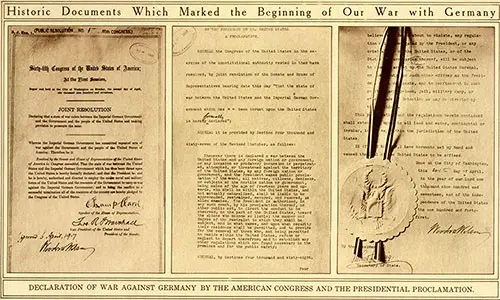
Historic Documents Which Marked the Beginning of Our War with Germany. Declaration of War Against Germany by the American Congress, and the Presidential Proclamation. The War of the Nations, New York Times, 1919. GGA Image ID # 195bcbf5a5
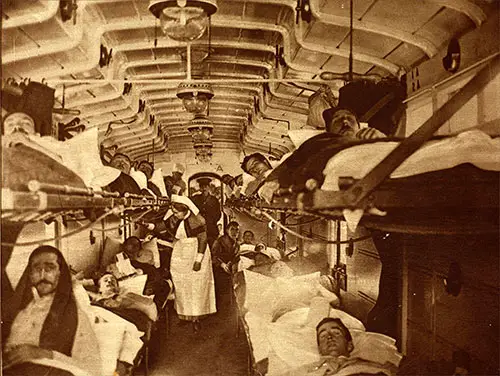
Hospital Express Train of the British Red Cross Provided with Nurses, Doctors, and Every Comfort, Speeding toward the Coast Where the Wounded Were to Be Taken to England. Photograph © British Official Photo, from Underwood & Underwood. The War of the Nations, New York Times, 1919. GGA Image ID # 195beb5009
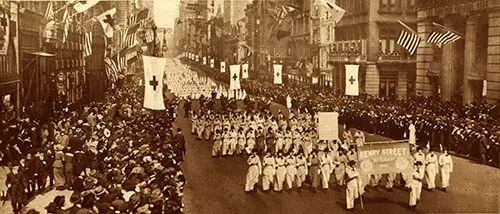
Red Cross Parade, Bringing Together the Largest Body of War Nurses Ever Assembled in This Country, Estimated at 20,000, Passing down Fifth Avenue, New York, Cheered by 300,000 People. Photograph © times Photo Service. The War of the Nations, New York Times, 1919. GGA Image ID # 195befddc5
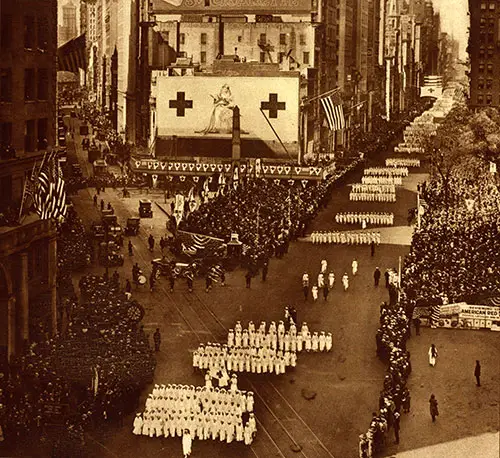
President Wilson Led and Reviewed the Great Red Cross Parade in New York at the Opening of the Second War Fund Campaign. At Left Is a Vista of Broadway Closed by the Times Building at times Square. Photograph © Times Photo Service. The War of the Nations, New York Times, 1919. GGA Image ID # 195c33a65a
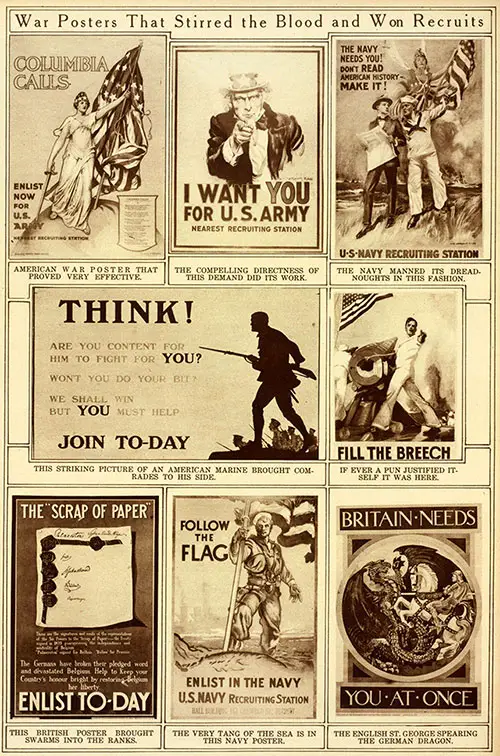
War Posters That Stirred the Blood and Won Recruits: American War Poster That Proved Very Effective. The Compelling Directness of This Demand Did Its Work. The Navy Manned Its Dreadnoughts in This Fashion. This Striking Picture of an American Marine Brought Comrades to His Side. If Ever a Pun Justified Itself It Was Here. This British Poster Brought Swarms into the Ranks. The Very Tang of the Sea Is in This Navy Poster. the English St. George Spearing the German Dragon. The War of the Nations, New York Times, 1919. GGA Image ID # 195cff377f
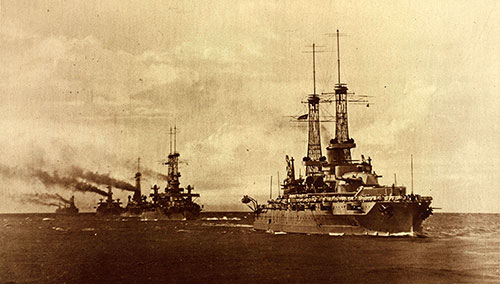
American Fleet in Atlantic Waters That Has Upheld Navy Traditions. United States Battleships in “line of Column, ” Led by One of the Largest Superdreadnoughts. The War of the Nations, New York Times, 1919. GGA Image ID # 195d16d7bb
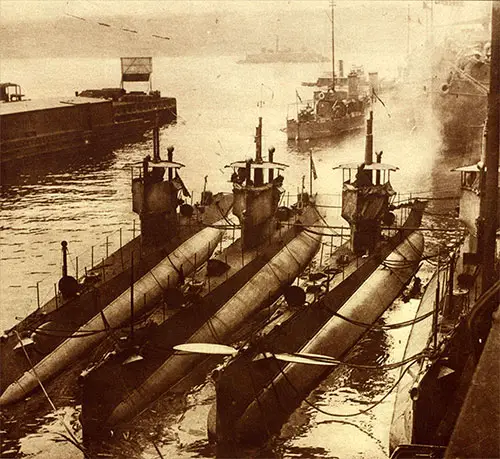
American Submarines of the K-Class Fitted out with Machinery and Equipment of the Latest Type to Be Used in Case of Hostile Descent on Our Coast. Photograph © Central News Photo Service. The War of the Nations, New York Times, 1919. GGA Image ID # 195d22b592
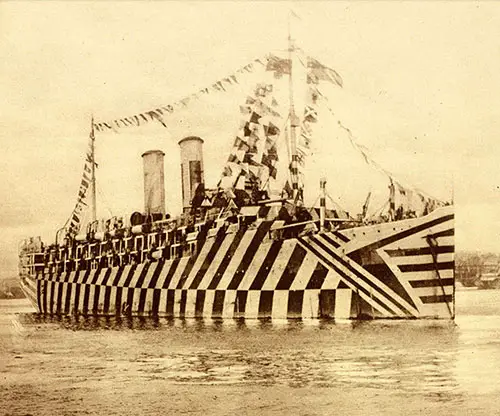
Camouflage of Ships to Deceive the Submarines. The Zebra Striped British Transport Osterley as She Appeared in New York Harbor November 11, 1918. She Was Decked with Flags in Celebration of the Armistice Signed on That Day. Photograph © Underwood & Underwood. The War of the Nations, New York Times, 1919. GGA Image ID # 195d3d7fb6
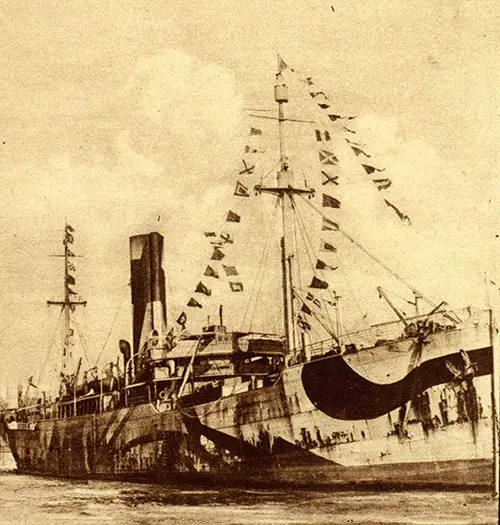
A Mystifying Camouflage Which Would Make It Very Difficult for an Undersea Pirate to Torpedo This Ship. Photograph © Underwood & Underwood. The War of the Nations, New York Times, 1919. GGA Image ID # 195d4ccec7
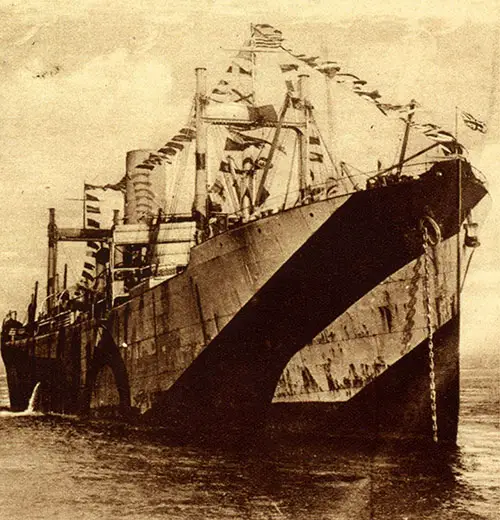
A British Ship Whose Bewildering Markings Have Enabled It on Many Trips to Baffle the Submarines. Photograph © Underwood & Underwood. The War of the Nations, New York Times, 1919. GGA Image ID # 195d78e66b
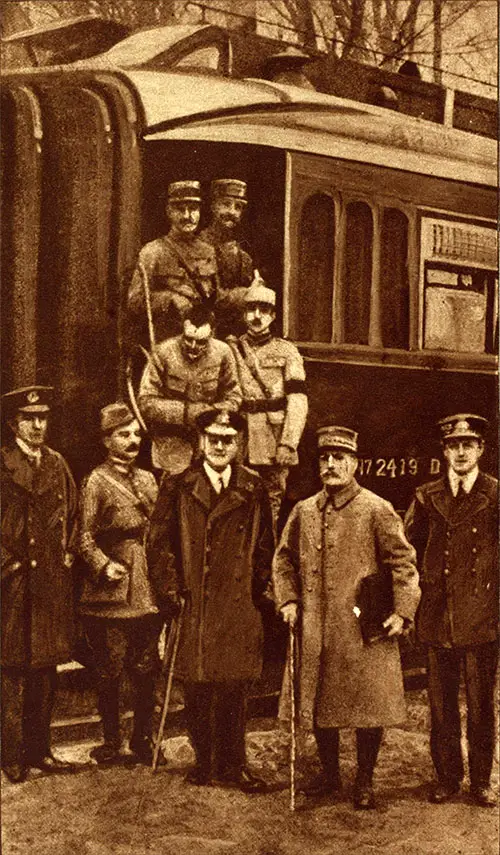
Marshal Foch, Carrying the Signed Armistice, Preparing to Take the Train for Paris. The War of the Nations, New York Times, 1919. GGA Image ID # 195e6a2b7e
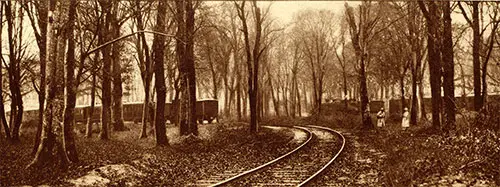
The Spot in the Forest of Compiegne, France, Where the Armistice with Germany Was Signed, November 11, 1918. On the Left Is the Train That Formed the Headquarters of Marshal Foch and on the Right That Occupied by the German Envoys. Photograph © Underwood & Underwood. The War of the Nations, New York Times, 1919. GGA Image ID # 195e811f8c
The most momentous event of the year 1918 was the signing of the armistice between the Allies and Germany on Nov. 11, which, while it did not formally end the war, virtually accomplished that result since it made the resumption of hostilities by Germany impossible. The negotiations took place in the railroad car in the Forest of Compiegne, where Marshal Foch had his headquarters. The German delegates reached the spot after a long automobile journey that was made to include the districts where there had been wanton devastation by the German armies, whether by accident or design. The discussion lasted for three days, during which time the German envoys had their sleeping and dining quarters in the train, shown on the right of the picture above. The Germans and Allied Forces made only minor modifications in the terms, and after the armistice was signed, Marshal Foch proceeded to Paris.
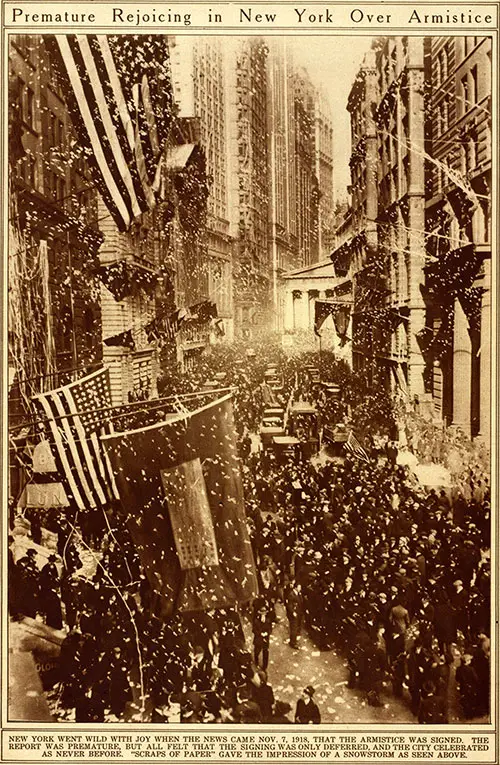
Premature Rejoicing in New York over Armistice. New York Went Wild with Joy When the News Came Nov. 7, 1918, That the Armistice Was Signed. the Report Was Premature, but All Felt That the Signing Was Only Deferred, and the City Celebrated as Never Before. “scraps of Paper” Gave the Impression of a Snowstorm as Seen Above. The War of the Nations, New York Times, 1919. GGA Image ID # 195e93445c
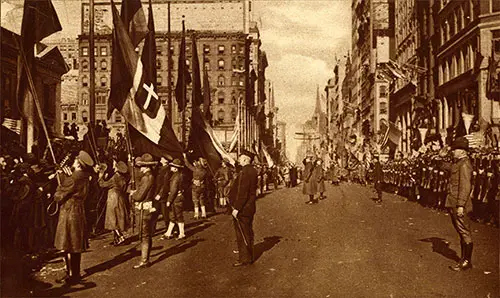
A Feature of the Exultant Demonstrations in New York over the Armistice's Signing was the Ceremony of Saluting the Victorious Flags of the Allies at the Public Library. The Italian Flag Is Just Being Raised. Photograph © Underwood & Underwood. The War of the Nations, New York Times, 1919. GGA Image ID # 195eb08d6a
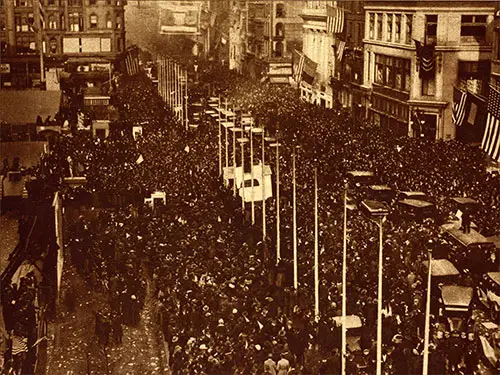
On November 11, 1918, the Streets of the Metropolis Were Packed with Cheering Throngs. At 42nd Street and Fifth Avenue, Shown above, Traffic Was Almost Impossible. Photograph © Underwood & Underwood. The War of the Nations, New York Times, 1919. GGA Image ID # 195ecf76dc
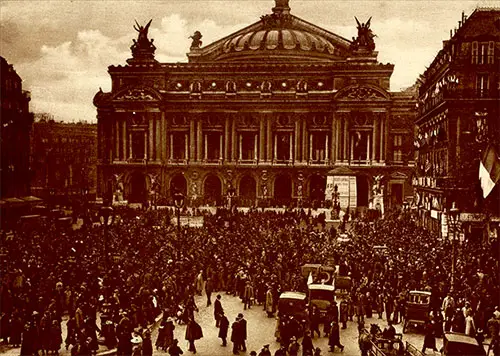
Capital of France Wild with Delight over Victory. The Place De L’opera in Paris Was Crowded on Nov. 11, 1918, When the Band of the Garde Republicaine Increased the Frenzy of Patriotic Feeling by Playing the “Marseillaise” and “the Sambre and the Meuse.” The War of the Nations, New York Times, 1919. GGA Image ID # 195f2c9469
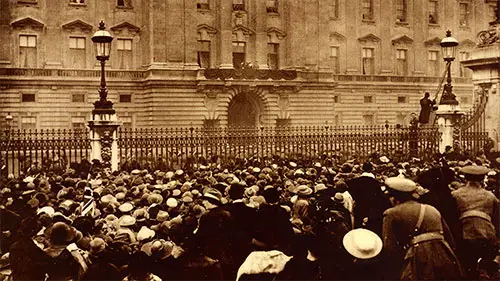
King and People Alike Rejoiced in London over Signing of Armistice. Vast Throngs Gathered before Buckingham Palace in London Nov. 11 and Cheered the King When He Appeared on the Balcony. Photograph © Western Newspaper Union. The War of the Nations, New York Times, 1919. GGA Image ID # 1960361674
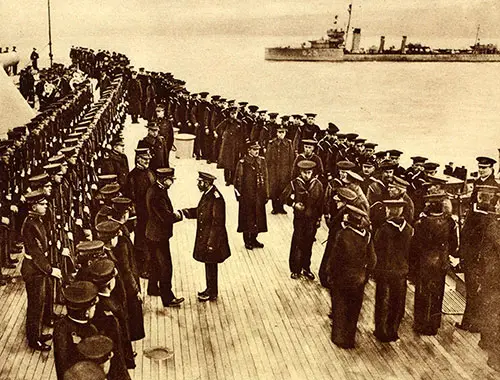
U. S. Admiral Rodman, Accompanied by Admiral Sims, Extending a Cordial Greeting to King George of England as the Latter Came on Board the New York, the Flagship of the American Dreadnought Squadron. Photograph © Underwood & Underwood. The War of the Nations, New York Times, 1919. GGA Image ID # 1960981f9c
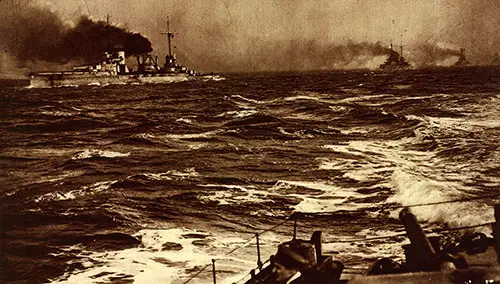
Surrender of German High Seas Fleet to British off Coast of Scotland. View from a British Destroyer of the German Fleet Steaming in to Surrender, Morning of November 21, 1918. Photograph © British Official. The War of the Nations, New York Times, 1919. GGA Image ID # 1960b58f7e
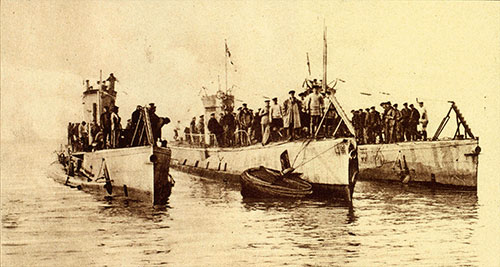
Three Surrendered U-boats with the German Crews Who Brought Them to England and Then Received Transportation Back to Germany. Photograph © British Official. The War of the Nations, New York Times, 1919. GGA Image ID # 1960dfc06d
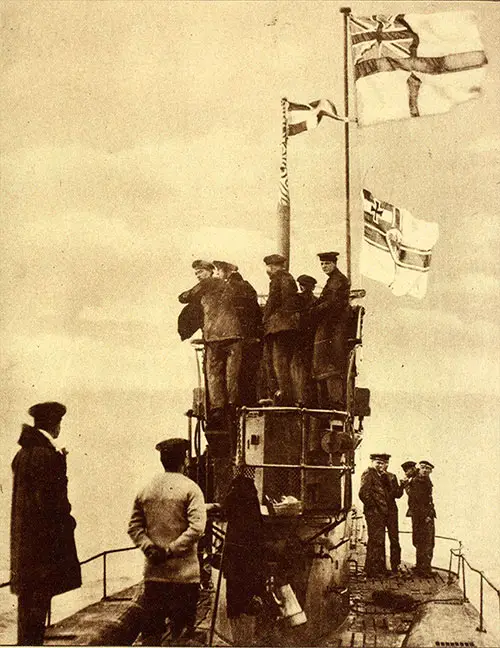
Close-up View of German U-boat 48 Going to Harwich, with the English Flag Floating above That of the German Empire. The Germans Protested against Hauling down Their Flag, but to No Avail. The War of the Nations, New York Times, 1919. GGA Image ID # 1961011fb3
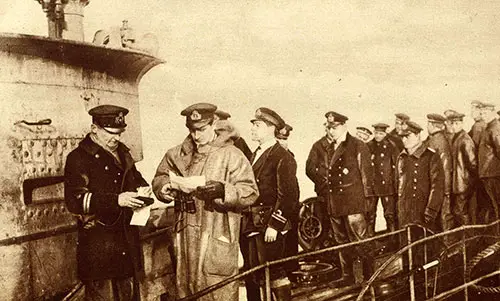
Inglorious End of German Submarine Warfare. German Commander Surrendering His Vessel to British Naval Officer, after Signing a Statement to the Effect That His Craft Was in Perfect Condition When Given Up. Photograph © International Film Service. The War of the Nations, New York Times, 1919. GGA Image ID # 19610b5166
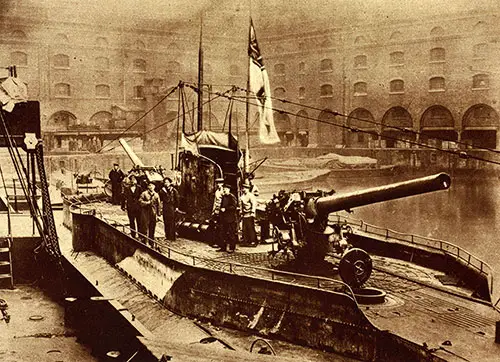
The U-155, Yielded up under the Armistice Terms, Looking from Stern toward Bow. It Has Guns Mounted on Turntables, Both Fore and Aft the Conning Tower, Outranging Those of Any Allied Merchantman. US Official Photograph. The War of the Nations, New York Times, 1919. GGA Image ID # 19614125ed
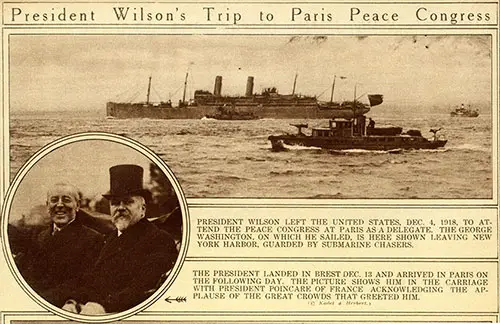
President Wilson’s Trip to Paris Peace Congress. President Wilson Left the United States, Dec. 1, 1918, to Attend the Peace Congress in Paris as a Delegate. The George Washington. on Which He Sailed, Is Here Shown Leaving New York Harbor. Guarded Ry Submarine Chasers. The President Landed in Brest on December 13 and Arrived in Paris on the following Day. The Picture Shows Him in the Carriage with President Poincare of France Acknowledging the Applause of the Great Crowds That Greeted Him. Photograph © Kadel & Herbert. The War of the Nations, New York Times, 1919. GGA Image ID # 19614261aa
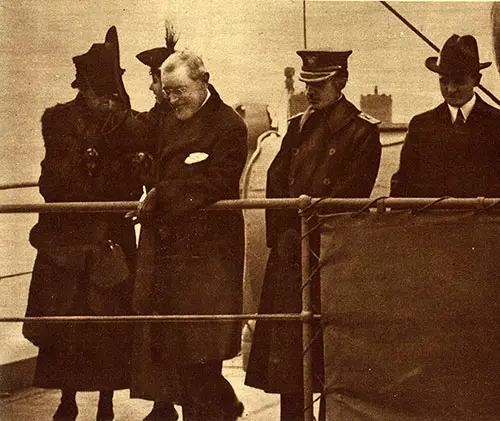
President from the Topmost Deck of the George Washington, Immediately above the Bridge. Lifting His Hat in Recognition of the Cheers of the Crowd on the Hoboken Pier. Photograph © Paul Thompson. The War of the Nations, New York Times, 1919. GGA Image ID # 196147d070
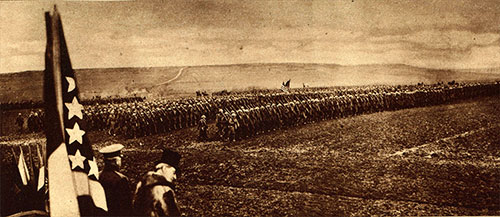
President with Paris Throngs and American Troops. President Wilson and General Pershing Reviewing United States Troops on Christmas Day at the Headquarters of the Army at Chaumont, 150 Miles from Paris. The War of the Nations, New York Times, 1919. GGA Image ID # 19616b8dff
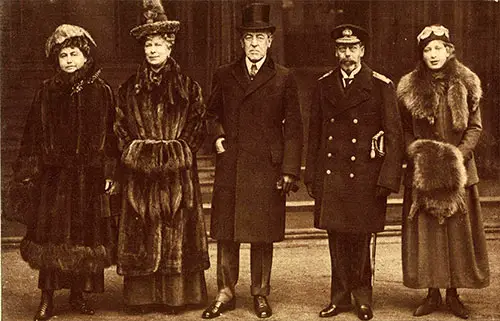
Great Welcome Extended to President in England. The President and Mrs. Wilson in Buckingham Palace, London, Photographed in Company of King George, Queen Mary and Their Daughter, Princess Mary Photograph © Central News Service. The War of the Nations, New York Times, 1919. GGA Image ID # 1961a9379e
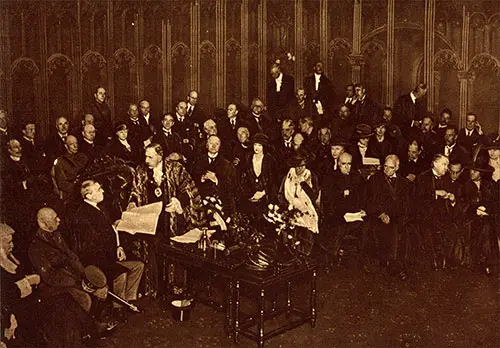
The Freedom of the City of London Tendered to President Wilson in the Guildhall, before an Assemblage including Some of England’s Greatest Men and Women. Photograph © Underwood & Underwood. The War of the Nations, New York Times, 1919. GGA Image ID # 1961e004c7
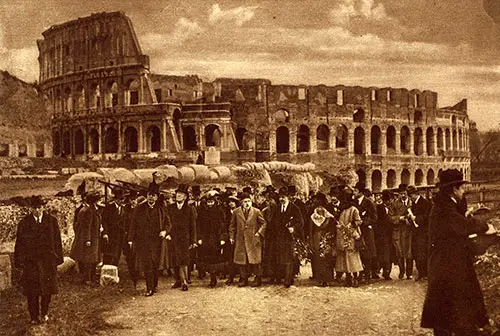
Unexampled Welcome to President Wilson in Italy. The Presidential Party Viewing Historic Spots in Rome in the Vicinity of the Coliseum. Previously the President Had Visited King Victor Emmanuel and the Pope. Photograph © Times Photo Service. The War of the Nations, New York Times, 1919. GGA Image ID # 1962355de2
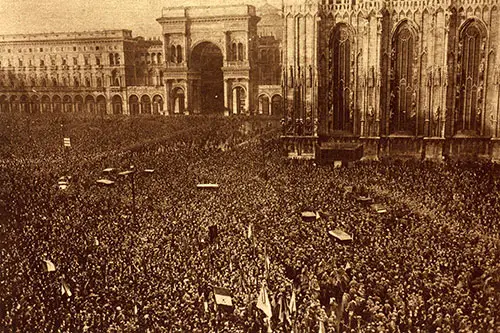
Such Throngs Had Never Crowded the Streets of Milan as Those That Greeted the President. The Demonstration Was Overpowering and Was the Most Remarkable Feature of His Visit to Italy. Photograph © Times Photo Service. The War of the Nations, New York Times, 1919. GGA Image ID #
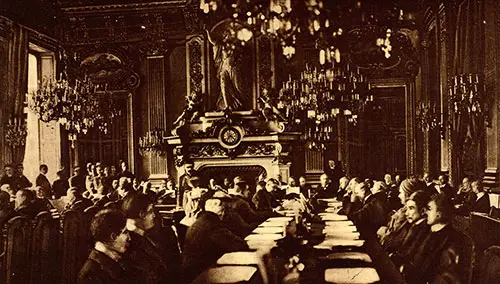
The Salle De La Paix in the Quai D’orsay, Paris, Where the Delegates to the Peace Congress Are Here Seen Assembled. Photograph © Times Photo Service. The War of the Nations, New York Times, 1919. GGA Image ID # 1962f13067
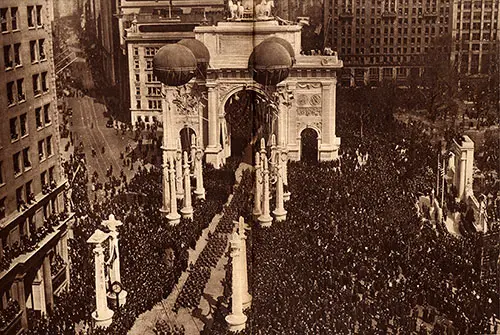
27th Division Passing under Victory Arch, New York Amid Greatest Throngs Ever Gathered in America. the Arch of Victory and Adjacent Pylons at Madison Square, Adorned with Sculptured Weapons and Names of Battles in Which the Troops Participated, March 25, 1919.The War of the Nations, New York Times, 1919. GGA Image ID # 1963235a1a
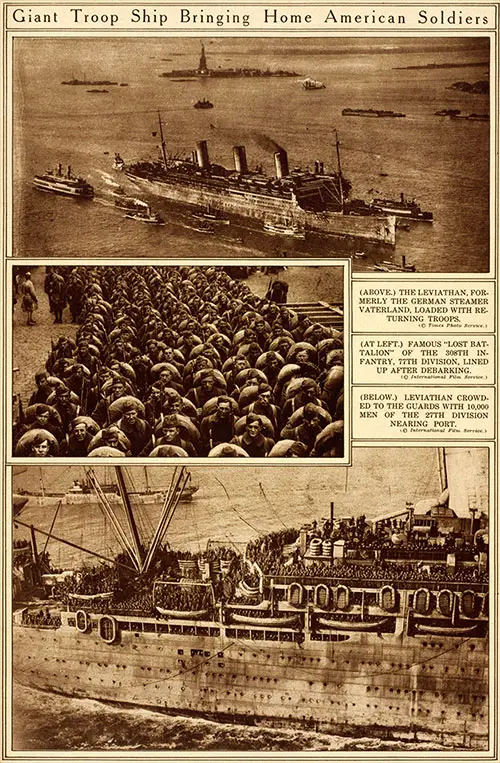
Giant Troop Ship Bringing Home American Soldiers. (above) the Leviathan, Formerly the German Steamer Vaterland, Loaded with Returning Troops. Photograph © Times Photo Service. (at Left) Famous “Lost Battalion” of the 308th Infantry, 77th Division, Lined up after Debarking. Photograph © International Film Service. (below) Leviathan Crowded to the Guards with 10,000 Men of the 27th Division Nearing Port. Photograph © International Film Service. The War of the Nations, New York Times, 1919. GGA Image ID # 1963310c50
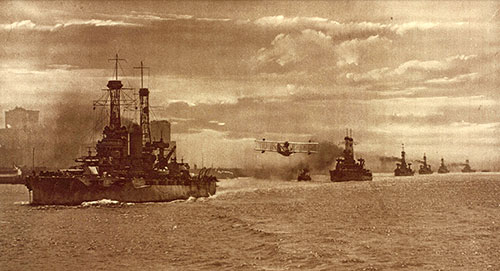
Greatest United States Naval Fleet Ever Assembled in American Waters. American Dreadnoughts and Superdreadnoughts Steaming into New York Harbor April 14, 1919. Photograph © Paul Thompson. The War of the Nations, New York Times, 1919. GGA Image ID # 196344f8bd
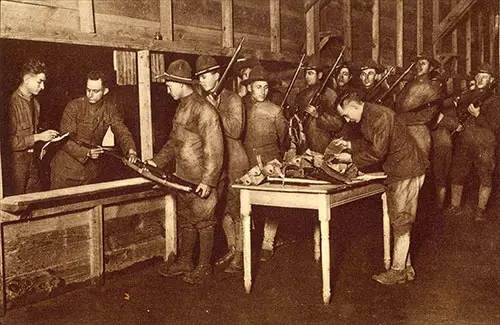
Men in Training Camp Returning to Civil Life. Soldiers Being Mustered out at Camp Dix, NJ after the Armistice's Signing, That Put an End to Hostilities. Men Turning in Their Guns. Photograph © Underwood & Underwood. The War of the Nations, New York Times, 1919. GGA Image ID # 19637fb928
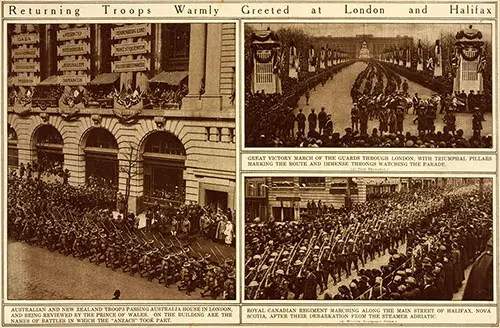
Returning Troops Warmly Greeted at London and Halifax. Australian and New Zealand Troops Passing Australia House in London, and Being Reviewed by the Prince of Wales. On the Building Are the Names of Battles in Which the “ANZACs” Took Part. Great Victory March of the Guards through London, with Triumphal Pillars, Marking the Route and Immense Throngs Watching the Parade. Photograph © Paul Thompson. After Their Debarkation from the Steamer Adriatic, Royal Canadian Regiment Marching along the Main Street of Halifax, Nova Scotia. Photograph © Western Newspaper Union. The War of the Nations, New York Times, 1919. GGA Image ID # 1963b29d08
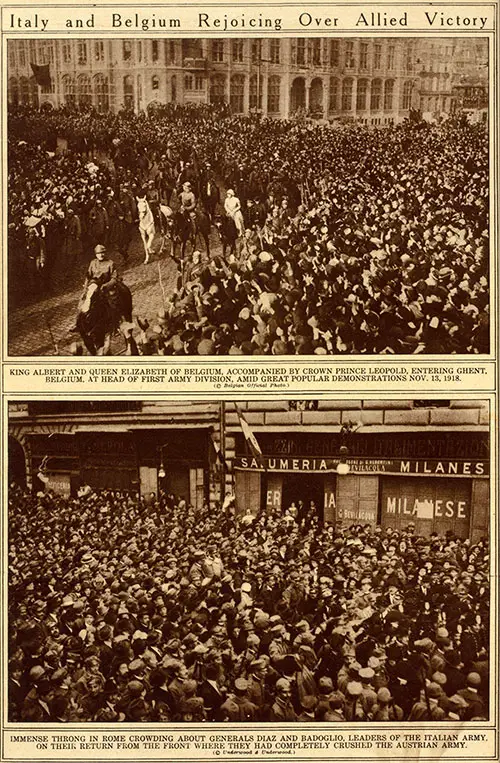
Italy and Belgium Rejoicing over Allied Victory! King Albert and Queen Elizabeth of Belgium, Accompanied by Crown Prince Leopold, Entering Ghent. Belgium, at Head of First Army Division, Amid Great Popular Demonstrations Nov. 13, 1918. Belgian Official Photograph. (below) Immense Throng in Rome Crowding about Generals Diaz and Badoglio, Leaders of the Italian Army, on Their Return from the Front Where They Had Completely Crushed the Austrian Army. Photograph © Underwood & Underwood. The War of the Nations, New York Times, 1919. GGA Image ID # 19642237a3
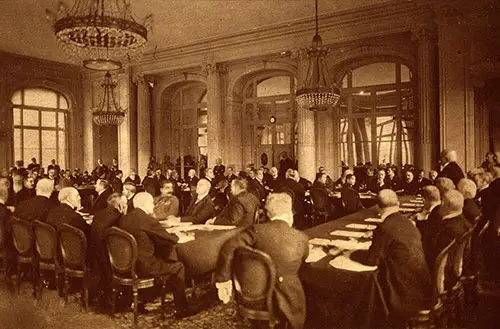
President of the Peace Conference, Premier Clemenceau, Addressing the German Delegates at the Trianon Palace Hotel, Versailles, May 7, 1919, Preliminary to the Delivery to Them the Peace Treaty. Photograph © Western Newspaper Union.. The War of the Nations, New York Times, 1919. GGA Image ID # 1964312047
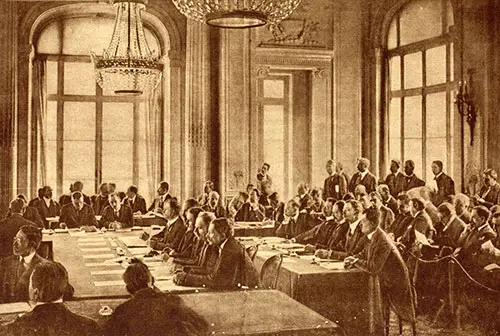
German Delegates at Versailles Listening Intently to Premier Clemenceau. Behind Them Are Their Secretaries, and Still Further Back Are the Representatives of the German Press. Drawing by J. Simont in L'Illustration. The War of the Nations, New York Times, 1919. GGA Image ID # 19644df0c4
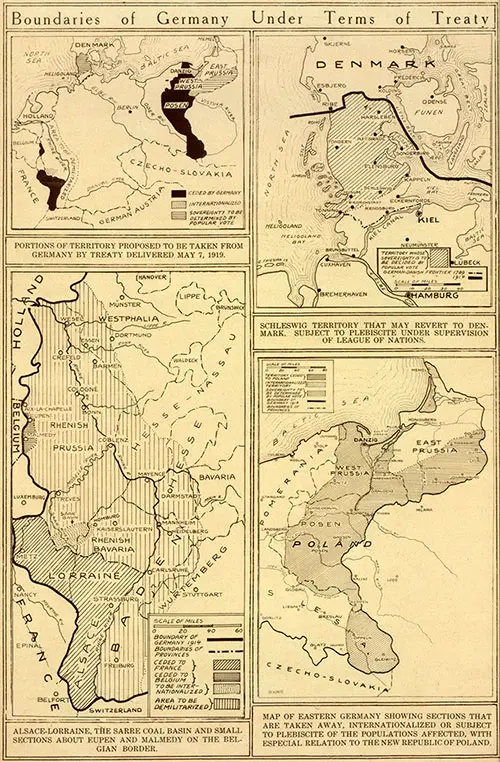
Boundaries of Germany under Terms of Treaty. Portions of Territory Proposed to Be Taken from Germany by Treaty Delivered May 7, 1919. Schleswig Territory That May Revert to Denmark. Subject to Plebiscite under Supervision of League of Nations. Alsace-Lorraine, the Sarre Coal Basin and Small Sections about Eupen and Malmedy on the Belgian Border. Map of Eastern Germany Showing Sections That Are Taken Away, Internationalized or Subject to Plebiscite of the Populations Affected, with Especial Relation to the New Republic of Poland. The War of the Nations, New York Times, 1919. GGA Image ID # 1964595f60
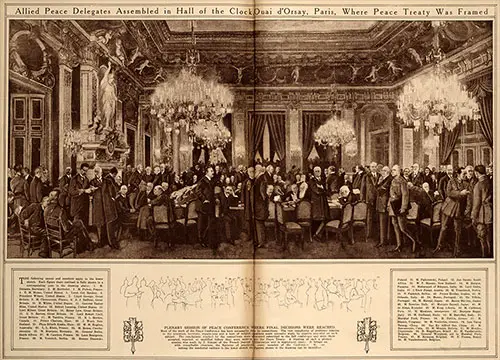
Allied Peace Delegates Assembled in Hall of the Clocks Quai d’Orsay, Paris, Where Peace Treaty Was Framed. Plenary Session of Peace Conference Where Final Decisions Were Reached. Most of the Work of the Peace Conference Has Been Necessarily Done by Committees. the Vast Complexity of Problems Relating to the Armistice, Territory, Reparations and a Host of Related Questions Made Intensive Study by Experts Essential on Each Subject. The Conclusions Reached by the Committees Were Afterward Submitted to the Full Conference and Were There Accepted, Rejected, or Modified before They Were Written into the Peace Treaty. A Drawing of Such a Plenary-session Was Made by J. Simont of the French Journal L'illustration and Is Reproduced Above. It Brings out with Remarkable Clearness the Features of Practically Every Member of the Conference by Consulting the Numbered Outlines in the Lower Sketch the Figures Shown in the Drawing Can Be Identified. The War of the Nations, New York Times, 1919. GGA Image ID # 196462d9d7
The following names and numbers apply to the lower sketch in the image above. Each figure there outlined is fully shown in a corresponding pose in the drawing above 1. M. Dutasta, Secretary. 2. M. Berthelot. 3. M. Pichón, France. 4. E. M. House, United States. 5. Lieut. Col. Hankey. 6. President Wilson, United States. 7. Lloyd George, Great Britain. 8. M. Clemenceau, France. 9. A. J. Balfour, Great Britain. 10. H. White, United States. 11. General Tasker Bliss, United States. 12. Robert Lansing, United States. 13. Lord Milner, Great Britain. 14. Bonar Law, Great Britain. 15. G. N. Barnes, Great Britain. 16. Lord Robert Cecil, Great Britain. 17. M. Tardieu, France. 18. R. L. Borden, Canada. 19. Prince Charron, Siam. 20. J. Ward, New Zealand. 21. Phya Bibadh Kosha, Siam. 22. W. M. Hughes, Australia. 23. L. L. Klotz, France. 24. M. Benes, Czechoslovakia. 25. M. Bratiano, Rumania. 26. General Botha, South Africa. 27. M. Cambon, France. 28. Leon Bourgeois, France. 29. M. Vesnitch, Serbia. 30. Roman Dmowski, Poland. 31. M. Paderewski, Poland. 32. Jan Smuts, South Africa. 33. W. F. Massey, New Zealand. 34. M. Burgos, Panama. 35. Maharajah of Bikaner, India. 36. Lord Sinha, India. 37. L'Emir Feisal, Arabia. 38. M. Trumbiteh, Serbia. 39. N. Pashitch, Serbia. 40. Prince Haidar, Arabia. 41. M. Orlando, Italy. 42. Dr. Moniz, Portugal. 43. Dr. Villela, Portugal. 44. M. Matsui, Japan. 45. Baron Makino, Japan. 46. M. Sonnino, Italy. 47. Marquis Saionji, Japan. 48. M. de Alsua, Ecuador. 49. M. King, Liberia. 50. M. Calderon, Peru. 51. M. Mantoux, interpreter. 52. Marquis Raggi, Italy. 53. M. Guilbaud, Haiti. 54. M. Barzillai, Italy. 65. Marshal Foch, France. 56. M. Politis, Greece 57. M. Blanco, Uruguay. 58. M. Venizelos, Greece. 59. Lou Tseng Tsiang, China. 60. Sao Ke Alfred Sze, China. 61. M. Bustamante, Cuba. 62. M.'Montes, Bolivia. 61. M. Mendes, Guatemala. 64. M. Magalhaes, Brazil. 65. M. Vandervelde, Belgium. 66. General Weygand, aid to Marshal Foch, France. 67. M. Hymans, Belgium. 68. E. Pessoa, Brazil. 69. M. Vandenheuvel, Belgium.
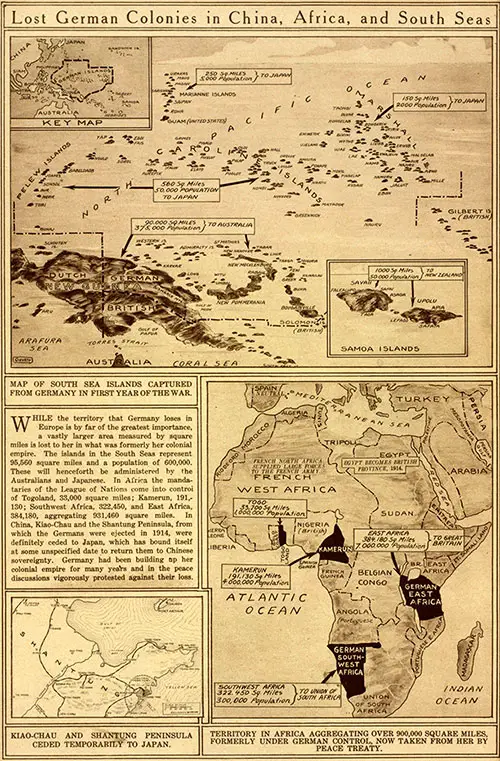
Lost German Colonies in China, Africa, and South Seas. (top) Map of South Sea Islands Captured from Germany in the First Year of the War. (bottom-left) Kiao-Chau and Shantung Peninsula Ceded Temporarily to Japan. (bottom-right) Territory in Africa Aggregating over 900, 000 Square Miles, Formerly under German Control, Now Taken from Her by the Terms of the Peace Treaty. The War of the Nations, New York Times, 1919. GGA Image ID # 19648e6169
While the territory that Germany loses in Europe is by far of the most significant importance, a vastly larger area measured by square miles is lost to her formerly colonial empire. The islands in the South Seas represent 95,560 square miles and a population of 600,000. The Australians and Japanese will henceforth administer these. In Africa, the League of Nations' mandataries controls Togoland, 33,000 square miles; Kamerun, 191,130; Southwest Africa, 322,450; and East Africa, 384,180, aggregating 931,460 square miles. In China, Kiao-Chau and the Shantung Peninsula, from which the Allied Forces ejected the Germans in 1914, were ceded to Japan, which has bound itself at some unspecified date to return them to Chinese sovereignty. Germany had been building her colonial empire for many years and vigorously protested against their loss in the peace discussions.
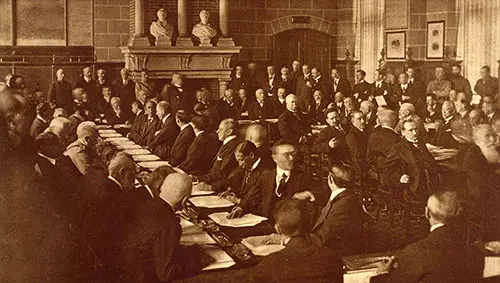
Receipt by the Austrian Delegation of Allied Peace Terms, June 2, 1919. Premier Clemenceau Addressing Delegates of Austria at St. Germain-en-Laye, before Delivery of Treaty. Photograph © Underwood & Underwood. The War of the Nations, New York Times, 1919. GGA Image ID # 1964adb4de
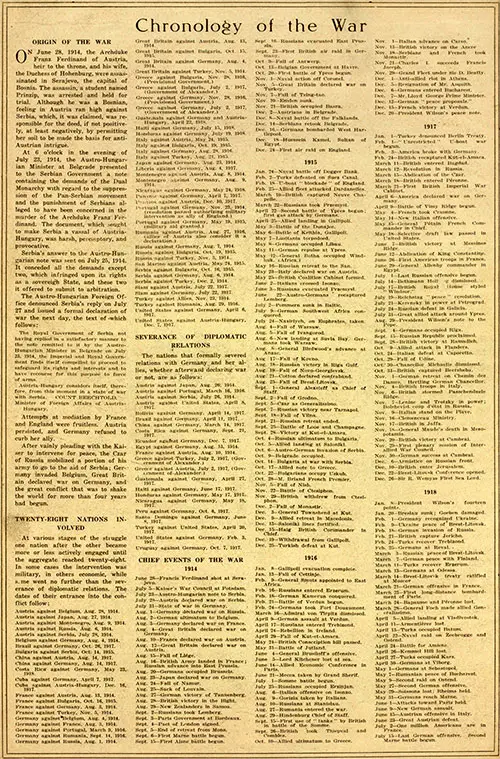
Chronology of the War including: Origin of the War; Twenty-Eight Nations Involved; Severance of Diplomatic Relations; And Chief Events of the War by Year (1914-1918). The War of the Nations, New York Times, 1919. GGA Image ID # 196515b68f
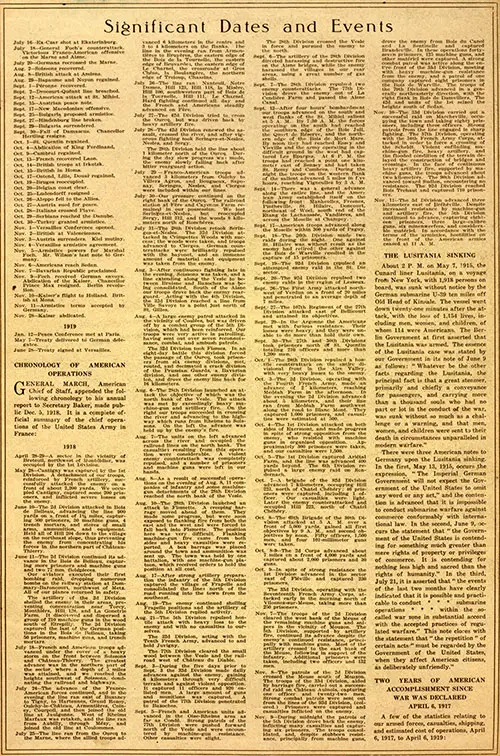
Significant Dates and Events. Chief Events of the War (1918 Continued and 1919), Chronology of American Operations. General March, American Chief of Staff, Appended the following Chronology to His Annual Report to Secretary Baker, Made Public Dec. 5, 1918. It Is a Complete Official Summary of the Chief Operations of the United States Army in France. The Lusitania Sinking is also Discussed -- about 2 P. M. on May 7, ?915, the Cunard Liner Lusitania, on a Voyage from New York, with 1, 918 Persons Onboard, Was Sunk without Notice by the German Submarine U-39 Ten Miles off Old Head of Kinsale. the Vessel Went down Twenty-one Minutes after the Attack, 'with the Loss of 1.154 Lives, including Men, Women, and Children, of Whom 114 Were Americans. The War of the Nations, New York Times, 1919. GGA Image ID # 19657136d6
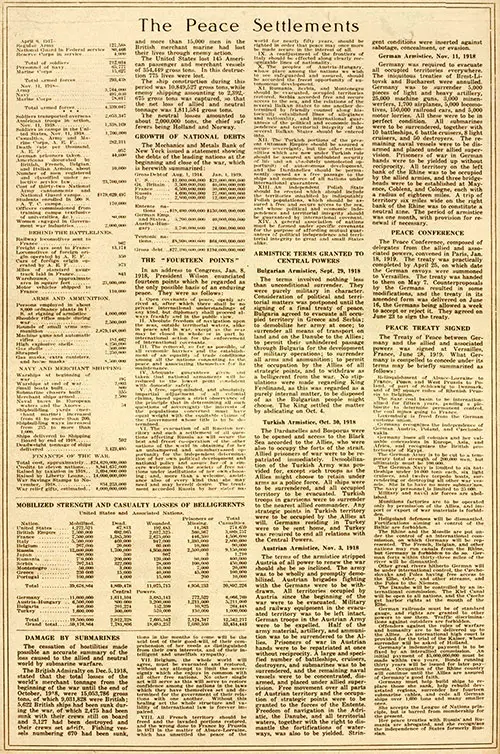
The Peace Settlements. Two Years of American Accomplishment since War Was Declared April 6, 1917. a Few of the Statistics Relating to Our Armed Forces, Casualties, Shipping, and Estimated Cost of Operations, April 6, 1917, to April 6, 1919. Growth of National Debts, The "Fourteen Points," Mobilized Strength and Casualty Losses of Belligerents (Shown Below), Damage b Submarines, Armistice Terms Granted to Central Powers, Peace Conference, and the Peace Treaty Signed. The War of the Nations, New York Times, 1919. GGA Image ID # 1965d24b0f
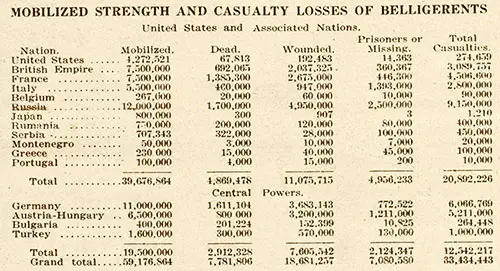
Table of Mobilized Strength and Casualty Losses of Belligerents United Staten and Associated Nations. The War of the Nations, New York Times, 1919. GGA Image ID # 19660eec19
